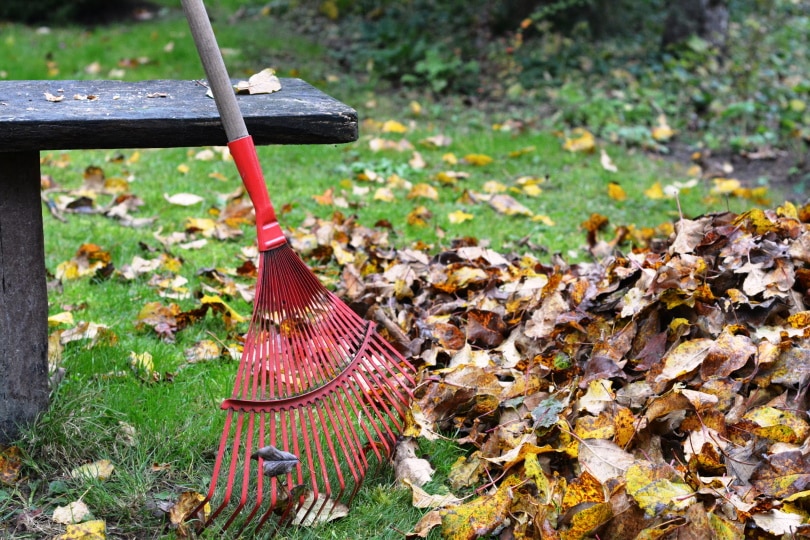Can You Burn Leaves in a Fire Pit? 4 Simple Steps
-
Pete Ortiz
- Last updated:

The smell of burning leaves throughout summer intensifies around autumn. It is distinct and memorable but also marks homeowners’ busiest time. They must rake, rake, and rake again leaves as deciduous trees rain down leaves during this time.
After collecting them into a pile, a possible way to dispose of them is through burning. Since you don’t want to destroy your precious lawn with burnt patches, a fire pit becomes handy. Can you really burn leaves in a fire pit safely? Yes, it is possible to burn leaves in a fire pit, and in this article, we will show you how.
Burning Leaves in a Fire Pit
Fire pits are common and one the most important sources of outdoor heat in many homes. According to Statista, almost 57% of homeowners have fire pits¹ fueled by wood or gas. The availability of fire pits also makes them a possible place for burning leaves.
However, from its design, a fire pit should be smokeless and emit enough heat to form a conducive environment for humans. Unfortunately, leaves are not smokeless and do not give off enough heat consistently, but it is possible to burn them in a fire pit.
The 4 Steps on How to Burn Leaves in a Fire Pit
1. Collect and Dry the Leaves on a Tarp

Rake and collect dry leaves in heaps before placing them on a tarp to dry under the sun for some hours or days. This is because moist leaves burn slowly and release more smoke than dry leaves. Furthermore, they also give off hydrocarbons and other compounds that will irritate the eyes and the throat. And for your information, some hydrocarbons are carcinogenic¹.
- Place the leaves on a tarp under the sun for a few hours or days, depending on the status of the leaves and the intensity of the sun. If the leaves have been rained or snowed on, they will take longer to dry. Likewise, cloudy days are colder; thus, leaves require more time to dry.
- Occasionally rake through the leaves. Doing this brings wet leaves from the bottom to the surface, where they will dry much faster.
- Heap the leaves in a large pile and cover them in a waterproof tarp if it starts to rain or snow.
2. Sort Through the Pile to Remove Poisonous Leaves
Not only are some plants deadly when eaten, but their smoke is also dangerous and may cause long-term health problems. So, removing them from the main pile is safer. Examples are¹ castor oil plants, white cedar, and coral trees.
3. Check Local Laws
Don’t get yourself into trouble with authorities over burning leaves. Check if local laws allow you to burn leaves by asking neighbors, contacting authorities, or visiting the official website to look for fire regulations.
However, some states temporarily ban outdoor fires at the peak of the dry season if you live close to the forest and there is the likelihood of fire spreading out or during windy months.
4. Prepare the Pit for Burning Leaves
Remove ash and unused firewood from the pit, and then place a small heap of leaves before starting the fire. Use a piece of paper or old boxes to start the fire. A small dose of lighter fluid is also ok, though, use it carefully.
Let the fire spread over the heap before adding more leaves. Repeat the same until the whole heap is gone. Remember to occasionally disturb the heap with a long piece of wood if it starts producing a lot of smoke. In addition, remove ashes to improve airflow and create more room.

Why Shouldn’t You Fill the Fire Pit Before Starting a Fire?
- Leaves Will Not Completely Burn: Heaped leaves have limited air space and may suffocate the fire immediately after starting it. Working with small heaps gives the fire enough space to suck in air and spread out.
- The Pit Will Produce a Lot of Smoke: Due to incomplete combustion taking place, working with large heaps produces a lot of smoke.
Does Burning Leaves in a Fire Pit Hurt the Environment?
Yes, burning anything harms the environment.
Leaves store carbon which combines with oxygen during combustion to form carbon dioxide (CO2) and nitrogen oxides. CO2 is a greenhouse gas¹ that traps heat, raising global temperature. While the CO2 from a small fire pit may be negligible, if the entire state burns leaves every weekend, tons of gasses produced are detrimental and contribute immensely to melting glaciers, extreme droughts, and food shortages.
What Is the Safest Way to Dispose of Leaves?
1. Composting
Collect leaves and mowed grass and heap them in a dug-out pit or a compost bin. Pile them in 5- to 6-inch-thick layers as you add a compost maker. Let them decompose in a warm moist environment¹ for 60+ days to form manure.

2. Use Them as Mulch
Shred leaves and spread on flower beds, around trees, or in the garden as a layer of mulch. They will protect plants from wilting and reduce water bills.
Conclusion
Other than the resulting hydrocarbons and smoke, burning leaves in a fire pit is safe. Start by drying leaves under the sun, placing small heaps in a pit, and gradually adding more leaves as the fire burns. Rather than burning leaves, you may also exploit compositing and using leaves as mulch as cheaper and environmentally friendly alternatives.
Featured Image Credit: ROMAN DZIUBALO, Shutterstock
Contents


